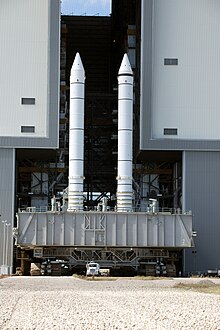Advanced Solid Rocket Motor
 |
|
| Manufacturer |
Thiokol, later ATK United Space Boosters International, Pratt and Whitney |
|---|---|
| Country of origin | United States |
| Used on | Space Shuttle |
| General characteristics | |
| Height | 45.46 m (149.16 ft) |
| Diameter | 3.71 m (12.17 ft) |
| Gross mass | 590,000 kg (1,300,000 lb) |
| Engine details | |
| Thrust | 12,000 kN (2,800,000 lbf) |
| Burn time | 127 seconds |
| Fuel | PBAN-APCP |
The Space Shuttle Solid Rocket Boosters (SRBs) were the first solid fuel motors to be used for primary propulsion on a vehicle used for human spaceflight and provided the majority of the Space Shuttle's thrust during the first two minutes of flight. After burnout, they were jettisoned and parachuted into the Atlantic Ocean where they were recovered, examined, refurbished, and reused.
The SRBs were the most powerful rocket motors ever flown. Each provided a maximum 13,800 kN (3,100,000 lbf) thrust, roughly double the most powerful single-combustion chamber liquid-propellant rocket engine ever flown, the Rocketdyne F-1. With a combined mass of about 1,180,000 kg (2,600,000 lb), they comprised over half the mass of the Shuttle stack at liftoff. The motor segments of the SRBs were manufactured by Thiokol of Brigham City, Utah, which was later purchased by ATK. The prime contractor for most other components of the SRBs, as well as for the integration of all the components and retrieval of the spent SRBs, was USBI, a subsidiary of Pratt and Whitney. This contract was subsequently transitioned to United Space Alliance, a limited liability company joint venture of Boeing and Lockheed Martin.
Out of 270 SRBs launched over the Shuttle program, all but four were recovered – those from STS-4 (due to a parachute malfunction) and STS-51-L (Challenger disaster). Over 5,000 parts were refurbished for reuse after each flight. The final set of SRBs that launched STS-135 included parts that flew on 59 previous missions, including STS-1. Recovery also allowed post-flight examination of the boosters, identification of anomalies, and incremental design improvements.
...
Wikipedia
